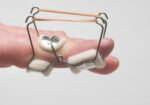CEUs in der Ergotherapie verstehen
Was sind CEUs und warum sind sie wichtig?
Continuing Education Units (CEUs) sind der Grundstein der beruflichen Weiterentwicklung von Ergotherapeuten. Sie stellen sicher, dass die Praktiker über neue Therapiemethoden, Forschungsfortschritte und ethische Standards auf dem Laufenden bleiben. Der Abschluss von CEUs erfüllt nicht nur die Zulassungsvoraussetzungen, sondern hilft Ergotherapeuten auch, ihre klinische Kompetenz zu verbessern und ihr professionelles Instrumentarium zu erweitern.
Im Gesundheitswesen hängen die Ergebnisse der Patienten stark von evidenzbasierter Praxis ab. Durch die Anmeldung bei Online-CEU-Kurse zur Ergotherapie, können Therapeuten ihre Fähigkeiten kontinuierlich verfeinern und in einem wachsenden Bereich wettbewerbsfähig bleiben.

Staatliche Zulassungsvoraussetzungen für Ergotherapeuten
Jeder Bundesstaat legt seine eigenen CEU-Anforderungen fest, die in der Regel zwischen 12 und 36 Kontaktstunden pro Erneuerungszyklus liegen. Einige Bundesstaaten, wie Kalifornien und Florida, haben spezielle Pflichtkurse in Ethik oder Recht. Um Compliance-Probleme zu vermeiden, sollten Sie sich vor der Kursanmeldung immer bei der Zulassungsbehörde Ihres Bundesstaates erkundigen.
Vorteile der Teilnahme an Online-CEU-Kursen zur Ergotherapie
Flexibilität und Komfort des Online-Lernens
Online-CEU-Kurse geben Ergotherapeuten die Freiheit, jederzeit und überall zu lernen. Egal, ob Sie einen Vollzeitjob haben oder eine Privatpraxis führen, diese Kurse fügen sich nahtlos in Ihren Zeitplan ein. Sie können Lektionen in Ihrem eigenen Tempo pausieren, zurückspulen und erneut ansehen – ein Luxus, der im traditionellen Unterricht oft nicht möglich ist.
Kosteneffizienz im Vergleich zu Präsenzkursen
Traditionelle Seminare können Hunderte von Dollar kosten, Reise- und Übernachtungskosten nicht eingerechnet. Online-CEU-Plattformen bieten jedoch günstige Abonnements oder Pay-per-Course-Modelle an und machen Weiterbildung so leichter zugänglich. Einige bieten sogar kostenlose CEUs oder Schnupperkurse an, wodurch Fachleute Geld sparen und trotzdem ihren Bildungsbedarf decken können.
Bleiben Sie auf dem Laufenden mit Branchenstandards und Best Practices
Von der Telemedizin-Integration bis hin zu unterstützender Technologie entwickelt sich der Bereich der Ergotherapie rasant weiter. Online-CEU-Plattformen ermöglichen es Therapeuten, sich über neue Themen und modernste Techniken zu informieren, die die Behandlungsergebnisse und das berufliche Wachstum der Patienten direkt verbessern.
So wählen Sie den richtigen Online-CEU-Anbieter aus
Akkreditierung und AOTA-Zulassung
Vergewissern Sie sich vor der Anmeldung, dass der Anbieter AOTA (American Occupational Therapy Association) – zugelassen. Die Akkreditierung stellt sicher, dass der Kurs den nationalen Qualitätsstandards entspricht und für die Lizenzerneuerung in Ihrem Bundesstaat akzeptiert wird.
Kursvielfalt und angebotene Spezialisierungen
Suchen Sie nach Plattformen, die eine breite Auswahl an CEUs anbieten – von Pädiatrie über Geriatrie und Handtherapie bis hin zu psychischer Gesundheit. Diese Vielfalt ermöglicht es Ihnen, interessante Bereiche zu erkunden oder Ihr Fachwissen in einem bestimmten Fachgebiet zu vertiefen.
Rezensionen, Bewertungen und Empfehlungen von Kollegen
Lesen Sie immer Benutzerbewertungen und Diskussionen der OT-Community auf Plattformen wie Reddit oder AOTA-Foren. Einblicke von Kollegen offenbaren oft reale Vorteile und potenzielle Nachteile bestimmter CEU-Anbieter.
Vergleich der besten Online-CEU-Plattformen für OTs
Preispläne und Abonnementoptionen
Die Wahl einer CEU-Plattform hängt oft vom Preis und der Flexibilität ab. Einige der besten Online-CEU-Kurse zur Ergotherapie bieten abgestufte Abonnementmodelle für jedes Budget an. Abonnementmodelle sind ideal für Therapeuten die jährlich mehrere CEUs absolvieren, während die Option der Bezahlung pro Kurs für diejenigen geeignet ist, die gelegentlich nach Spezialthemen suchen.
Kursformate und Lernerfahrung
Das Lernformat kann sich erheblich auf das Engagement und die Wissensspeicherung auswirken. CEU-Plattformen bieten typischerweise:
- Videobasiertes Lernen: Dynamische, von einem Lehrer geleitete Sitzungen für visuelle Lerner.
- Textbasierte Module: Ideal zum schnellen Nachschlagen und für lesebasiertes Lernen.
- Interaktive Fallstudien: Angewandte Problemlösung, um Theorie und Praxis zu verbinden.
- Live-Webinare: Echtzeit-Interaktion mit Branchenexperten.
Zertifikatsausstellung und CE-Verfolgung
Zuverlässige CEU-Plattformen erstellen nach Abschluss automatisch digitale Zertifikate. Viele speichern auch eine Aufzeichnung Ihrer absolvierten Credits, sodass Sie für die Verlängerung Ihrer staatlichen Lizenzen prüfungsbereit sind.
Wichtige Themen der Online-CEU-Kurse
Handtherapie und Rehabilitation der oberen Extremitäten
Handtherapie ist eine der gefragtesten Spezialisierungen in der Ergotherapie. CEU-Kurse in diesem Bereich konzentrieren sich auf fortgeschrittene Techniken zur Behandlung von Hand- und oberen Extremitätenverletzungen, einschließlich Sehnenreparatur, Frakturen, Arthritis und postoperativer Rehabilitation. In diesen Kursen lernen Ergotherapeuten, wie sie Feinmotorik, Kraft und Geschicklichkeit verbessern und gleichzeitig die funktionelle Genesung von Patienten jeden Alters fördern können. Therapeuten erwerben wertvolle Kenntnisse in den Bereichen Schienen, Gelenkschutz und evidenzbasierte Interventionen zur Wiederherstellung der optimalen Handfunktion.
Geriatrische und häusliche Krankenpflege
Angesichts der rasanten Alterung der Weltbevölkerung unterstützen geriatrisch ausgerichtete Weiterbildungen Ergotherapeuten dabei, ältere Menschen dabei zu unterstützen, ihre Unabhängigkeit und Sicherheit zu bewahren. Die Kurse behandeln Sturzprävention, den Einsatz adaptiver Hilfsmittel und die Anpassung der häuslichen Umgebung. Diese grundlegenden Fähigkeiten bereiten Ergotherapeuten auf die individuelle Betreuung in der häuslichen Krankenpflege, im betreuten Wohnen und in der Langzeitpflege vor.
Psychische Gesundheit und Rehabilitationstechniken
CEUs im Bereich psychische Gesundheit erforschen Strategien zur Behandlung von Erkrankungen wie Angstzuständen, Depressionen und traumabedingten Störungen. Therapeuten erlernen therapeutische Kommunikation, sensorische Modulation und kognitiv-verhaltenstherapeutische Ansätze zur Förderung der emotionalen Regulierung und Genesung. Diese Kurse befähigen Ergotherapeuten, in verschiedenen Umgebungen, einschließlich psychiatrischer Einrichtungen und ambulanter Rehabilitationszentren, effektiv zu arbeiten.
Evidenzbasierte Praxis in der Ergotherapie
CEUs zur evidenzbasierten Praxis ermutigen Therapeuten, neueste Forschungsergebnisse in klinische Entscheidungen zu integrieren. Diese Kurse vermitteln Ergotherapeuten, wie sie Studien auswerten, Daten interpretieren und Evidenz in alltägliche Behandlungspläne einbringen. Durch die Verankerung bewährter Methoden können Therapeuten eine konsistente, ethische und effektive Versorgung ihrer Patienten gewährleisten.
So maximieren Sie den Lernerfolg aus Online-CEU-Kursen
Klare berufliche Ziele setzen
Legen Sie vor der Anmeldung Ihre Lernziele fest. Möchten Sie sich auf Handtherapie spezialisieren oder Ihre Fähigkeiten in der Kinderheilkunde vertiefen? Ein zielorientierter Ansatz stellt sicher, dass Ihre CEUs Ihren langfristigen Karrierezielen entsprechen.
Anwendung von Wissen auf reale Szenarien
Wenden Sie nach Abschluss jedes Moduls neue Techniken in Ihrem klinischen Umfeld an. Diese praktische Übung stärkt das Behalten und stärkt das Selbstvertrauen.
Online-Networking mit anderen Ergotherapeuten
Nehmen Sie an Online-Foren, Diskussionsgruppen und CEU-Webinaren teil, um mit Kollegen in Kontakt zu treten.
Häufige Fehler, die Sie bei der Auswahl von CEU-Kursen vermeiden sollten
Ignorieren von Akkreditierungsstandards
Gehen Sie niemals davon aus, dass alle Online-CEU-Kurse akkreditiert sind. Überprüfen Sie immer, ob der Kurs von AOTA oder Ihr staatliche Zulassungsbehörde um sicherzustellen, dass es für die Lizenzerneuerung angerechnet wird.
Quantität vor Qualität
Es mag zwar verlockend sein, günstigere oder kürzere Kurse zu wählen, um schnell Credits zu sammeln, aber qualitativ hochwertiges Lernen bietet langfristig mehr Vorteile. Suchen Sie nach evidenzbasierten und von Experten geprüften Kursen.
Fehlerhafte Erfassung der CEU-Credits
Die Pflege der CEU-Dokumentation ist bei Lizenzerneuerungen oder Audits von entscheidender Bedeutung. Nutzen Sie die CE-Tracking-Tools der Plattform oder erstellen Sie eine persönliche Tabelle, um den Überblick zu behalten.
Häufig gestellte Fragen zu Online-CEU-Kursen in Ergotherapie
Werden Online-CEU-Kurse von allen staatlichen Gremien anerkannt?
Die meisten Bundesstaaten akzeptieren Online-CEU-Kurse, sofern sie von der AOTA zugelassen sind oder die bundesstaatlichen Anforderungen erfüllen. Fragen Sie vor der Anmeldung immer bei Ihrer Zulassungsbehörde nach.
Wie viele CEUs benötigen Ergotherapeuten pro Jahr?
Die Anforderungen variieren je nach Bundesstaat, aber die meisten OTs benötigen alle ein bis zwei Jahre zwischen 12 und 36 CEUs für die Lizenzerneuerung.
Kann ich alle meine CEUs online absolvieren?
Ja, viele Bundesstaaten erlauben jetzt 100%-Online-CEUs, insbesondere seit der Ausweitung der Telemedizin und des digitalen Lernens nach 2020.
Sind kostenlose CEU-Kurse für die Lizenzerneuerung gültig?
Kostenlose Kurse können legitim sein, wenn sie von akkreditierten Institutionen oder von der AOTA anerkannten Organisationen angeboten werden. Überprüfen Sie jedoch immer die Akkreditierung, bevor Sie sich anmelden.
Wie kann ich überprüfen, ob ein CEU-Anbieter von der AOTA zugelassen ist?
Besuchen Sie die Verzeichnis der von der AOTA zugelassenen Anbieter oder prüfen Sie die Zulassungsnummer und Gültigkeitsdaten auf der Website des Anbieters.
Fazit: Investieren Sie mit Online-CEUs in Ihr Wachstum
Der Bereich der Ergotherapie lebt vom kontinuierlichen Lernen. Die Einschreibung in Online-CEU-Kurse zur Ergotherapie ermöglicht es Fachkräften, in einem sich schnell verändernden Gesundheitsumfeld die Nase vorn zu behalten. Ob Sie Ihre Lizenz erneuern, sich auf ein neues Gebiet spezialisieren oder einfach nur auf dem Laufenden bleiben möchten – die richtige Online-CEU-Plattform kann Ihre Karriere voranbringen und die Behandlungsergebnisse für Patienten verbessern.
Machen Sie also den nächsten Schritt: Wählen Sie einen von der AOTA zugelassenen Anbieter, setzen Sie sich klare Lernziele und beginnen Sie noch heute Ihre Reise zur professionellen Meisterschaft.
Mehr zum Lesen
Die Rolle eines Handtherapeuten bei der Ernährungserziehung zur Wundheilung
Von Brittany Day Die Rolle der Ernährung bei der Wundheilung Die Ernährung spielt eine wichtige Rolle bei den biologischen Faktoren, die zu einer normalen Wundheilung beitragen (Wundpflegeernährung). Bei Patienten ohne nährstoffreiche Ernährung kann es zu einer verminderten Zellproduktion, Kollagensynthese und Wundkontraktion kommen. Es gibt nur wenige wissenschaftliche Beweise, die die genaue Wissenschaft hinter der Ernährung erforschen und…
Mehr lesenBehandlung des steifen Fingers: Evidenz und Ergebnisse
Titel: Behandlung des steifen Fingers: Beweise und Ergebnisse Referenz: Yang, G., McGlinn, EP, & Chung, KC (2014). Behandlung des steifen Fingers: Beweise und Ergebnisse. Clinics in Plastic Surgery, 41(3), 501–512. https://doi.org/10.1016/j.cps.2014.03.011 Artikelrezension von: Tommi Hintnaus Die Fakten: Diese Studie konzentriert sich auf das Verständnis und die Behandlung der Fingersteifheit, einer Erkrankung, die gekennzeichnet ist durch…
Mehr lesenArtikelrezension: Trapezektomie und LRTI: Was können Patienten mit CMC-Arthrose 12 Monate nach dem Eingriff erwarten?
Janakiramanan, N., Miles, O., Collon, S., Crammond, B., McCombe, D. & Tham, SK (2021). Funktionelle Wiederherstellung nach Trapezektomie und Bandrekonstruktion und Sehneninterposition (Trapeziektomie und LRTI): Eine prospektive Längsschnittstudie. Das Journal of Hand Surgery, S0363-5023(21)00304-X. Vorab Online-Veröffentlichung. https://doi.org/10.1016/j.jhsa.2021.04.036 Die Dünnen: Patienten mit trapeziometakarpaler (TMC) Arthrose, die Kandidaten für eine Trapezektomie sind und…
Mehr lesenDie Einnahme von Alpha-Liponsäure über einen Zeitraum von 40 Tagen nach einer Karpaltunneloperation kann die Wahrscheinlichkeit der Entwicklung von Säulenschmerzen verringern.
Filippo, B., Granchi, D., Roatti, G., Merlini, L., Sabattini, T. & Baldini, N. (2017). Alpha-Liponsäure nach Dekompression des Nervus medianus am Karpaltunnel: Eine randomisierte kontrollierte Studie. Das Journal of Hand Surgery, 4, 236–42. The Skinny – Es wurde eine doppelblinde, randomisierte kontrollierte Studie durchgeführt. 64 Patienten wurden nach dem Medianwert zufällig in zwei Gruppen eingeteilt.
Mehr lesenMelden Sie sich an, um Updates direkt in Ihren Posteingang zu erhalten!
Melden Sie sich bei uns an und wir senden Ihnen regelmäßig Blogbeiträge zum Thema Handtherapie, Benachrichtigungen jedes Mal, wenn wir neue Videos und Tutorials hochladen, zusammen mit Handzetteln, Protokollen und anderen nützlichen Informationen.






